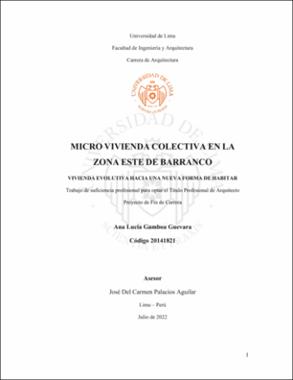| dc.contributor.advisor | Palacios Aguilar, José del Carmen | |
| dc.contributor.author | Gamboa Guevara, Ana Lucía | |
| dc.date.accessioned | 2022-09-01T16:32:47Z | |
| dc.date.available | 2022-09-01T16:32:47Z | |
| dc.date.issued | 2022 | |
| dc.identifier.citation | Gamboa Guevara, A. L. (2022). Micro vivienda colectiva en la zona este de Barranco Vivienda evolutiva hacia una nueva forma de habitar [Trabajo de suficiencia profesional para optar el Título Profesional de Arquitecto, Universidad de Lima]. Repositorio Institucional de la Universidad de Lima. https://hdl.handle.net/20.500.12724/16468 | es_PE |
| dc.identifier.uri | https://hdl.handle.net/20.500.12724/16468 | |
| dc.description.abstract | El significado de “hogar” viene asociado a un espacio de protección donde se realizan funciones básicas como el descanso, aseo, y alimentación, sin embargo, una nueva forma de habitar denominada, co-habitar, le otorga más valor al concepto de vivienda, convirtiéndola en un espacio activo y productivo dónde pueda ser posible ejercer el estilo de vida de cada usuario y permitir la posibilidad de ejercer la cohesión social para el desarrollo de un entorno de comunidad.
El presente proyecto es un modelo de micro vivienda colectiva, basada en el cohabitar, en la que, partiendo de un módulo compacto, se presentan una serie de tipologías versátiles que le permiten al usuario adaptar su vivienda a futuros cambios de acuerdo con sus nuevas necesidades y expectativas. Esta se dirige a tres tipos de usuarios de Lima Metropolitana; familias no tradicionales con una variedad de composiciones en su núcleo, y quienes se encuentran insatisfechos con la oferta de viviendas existente ya que no se acomoda a sus necesidades; asimismo, se incluyen a las familias tradicionales de la zona Este de Barranco quienes ejercen comportamientos colectivos y requieren mejorar su
calidad de vida debido a las precarias condiciones de su vivienda existente; y por último, a usuarios de la tercera edad, con la intención de incluirlos socialmente al conjunto, generando mayor oportunidad de crear una comunidad diversa e inclusiva.
El proyecto, emplazado en Barranco, busca activar la zona Este del distrito, considerada la zona olvidada, al límite de Surco Viejo, mediante espacios socioculturales y el atractivo de crear una vivienda colectiva compacta-económica; evolutiva; e inclusiva, con espacios intermedios que promuevan la cohesión social y activen la zona mediante su programa cultural en beneficio de los usuarios internos y externos. | es_PE |
| dc.description.abstract | The meaning of "home" is associated with a protective space where basic functions such
as rest, toilet, and food are performed, however, a new form of living called, co-living, gives more value to the concept of housing, making it an active and productive space where it may be possible to exercise the lifestyle of each user and allow the possibility of exercising social cohesion for the development of a community environment.
The present project is a model of collective micro housing, based on co-living, in which, starting from a compact module, a series of versatile typologies are presented that allow the user to adapt their home to future changes according to their new needs and expectations. This is aimed at three types of users in Metropolitan Lima; non-traditional families with a variety of compositions at their core, and those who are dissatisfied with the existing housing supply because it does not suit their needs; traditional families in the eastern part of Barranco who engage in collective behavior and need to improve their quality of life due to the precarious conditions of their existing housing; and finally, elderly users, with the intention of including them socially as a whole, generating greater opportunity to create a diverse and inclusive community.
The project, located in Barranco, seeks to activate the East zone of the district, considered the forgotten zone, at the limit of Surco Viejo, through socio-cultural spaces and the attraction of creating a compact-economic collective housing; evolutionary; and inclusive, with in-between spaces that promote social cohesion and activate the area through their cultural program for the benefit of internal and external users. | en_EN |
| dc.format | application/pdf | |
| dc.language.iso | spa | |
| dc.publisher | Universidad de Lima | |
| dc.rights | info:eu-repo/semantics/openAccess | * |
| dc.rights.uri | https://creativecommons.org/licenses/by-nc-sa/4.0/ | * |
| dc.source | Repositorio Institucional - Ulima | |
| dc.source | Universidad de Lima | |
| dc.subject | Vivienda compartida | es_PE |
| dc.subject | Vivienda multifamiliar | es_PE |
| dc.subject | Barranco (Lima Metropolitana) | es_PE |
| dc.subject | Shared housing | en_EN |
| dc.subject | Apartment houses | en_EN |
| dc.title | Micro vivienda colectiva en la zona este de Barranco Vivienda evolutiva hacia una nueva forma de habitar | es_PE |
| dc.title.alternative | Collective micro-housing in the east area of Barranco evolving housing towards a new way of living | en_EN |
| dc.type | info:eu-repo/semantics/bachelorThesis | |
| thesis.degree.level | Título Profesional | es_PE |
| thesis.degree.discipline | Arquitectura | es_PE |
| thesis.degree.grantor | Universidad de Lima. Facultad de Ingeniería y Arquitectura | es_PE |
| dc.publisher.country | PE | |
| dc.type.other | Trabajo de suficiencia profesional | |
| thesis.degree.name | Arquitecto | es_PE |
| renati.discipline | 731026 | |
| dc.identifier.isni | 121541816 | |
| renati.author.dni | 76179536 | |
| renati.level | https://purl.org/pe-repo/renati/level#tituloProfesional | * |
| renati.juror | Baez Barriga, Mónica Eliana | |
| renati.juror | Montestruque Bisso, Octavio Adolfo | |
| renati.juror | Rivas Lombardi, Carmen Angelica | |
| renati.juror | Palacios Aguilar, José del Carmen | |
| renati.type | https://purl.org/pe-repo/renati/type#trabajoDeSuficienciaProfesional | * |
| dc.subject.ocde | https://purl.org/pe-repo/ocde/ford#6.04.08 | |
| ulima.cat | OI | |



